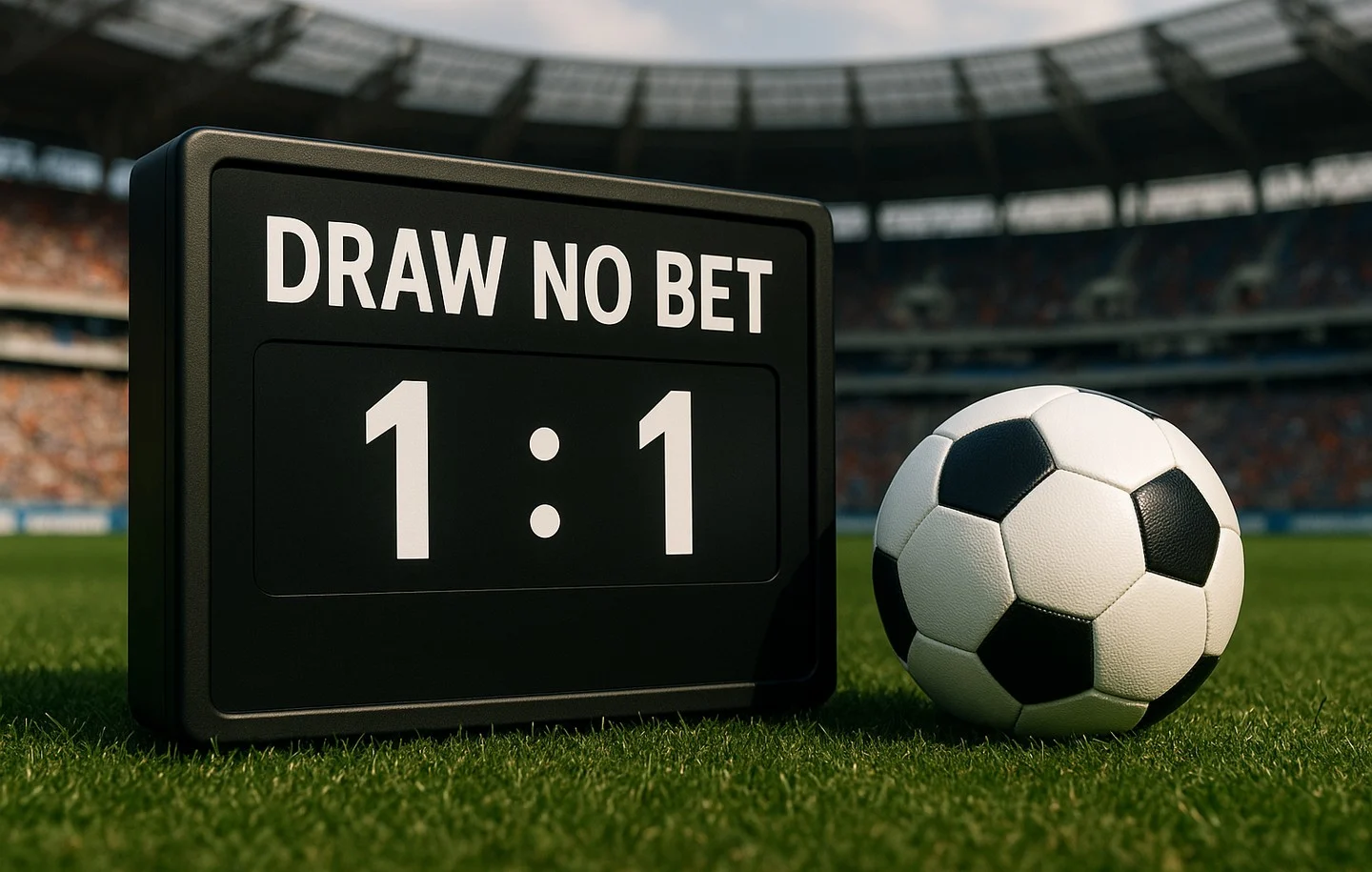Draw No Bet Meaning: Explaining a Popular Betting Market for New Bettors


- Fact Checked by: PokerListings
- Last updated on: July 16, 2025 · 6 minutes to read
What Does Draw No Bet Mean?
Draw No Bet (DNB) is a popular betting market offered by many bookmakers. It is a type of wager where the bettor chooses a team or player to win the match, but if the game ends in a draw, the bet is refunded. In other words, it eliminates the possibility of losing money due to a draw result.
How Does DNB Work?
The “Draw No Bet” (DNB) market is a simple and relatively safe betting option. You decide whether it is going to be a home or away team winning, and if the match ends in a draw, you don’t lose your stake — instead, the bookmaker refunds it. Essentially, DNB meaning in betting is to offer a secure alternative to a straight bet.
Basically, DNB transforms a traditional 3-way wager into a 2-way bet. With fewer possible outcomes, your risk is lower—you only lose if the team you back is defeated.
It’s crucial not to confuse DNB with the “12” market, where you’re betting on either team to win outright. In a “12” bet, a draw results in a lost stake, while a victory by either side earns you a win.
Draw No Bet Example for New Bettors
Let’s consider a Draw No Bet wager using the example of the match between Barcelona and Real Madrid. The odds for Barcelona to win without a draw (with a handicap of 0) are 1.72, while the same outcome for Real Madrid is offered at 2.10.
Let’s say you place a $100 bet on Barcelona at a Wisconsin sports betting site. The possible outcomes are:
- Barcelona wins in regular time – your bet is successful (payout $172);
- A draw in regular time – your stake is fully refunded (payout $100);
- Real Madrid wins in regular time – your bet loses.
Note that this bet only applies to the result at the end of regular time. If the match goes into overtime or a penalty shootout, the DNB wager is settled using the regular-time result.
For example, if you bet on Barcelona and the game end in a draw during regular time, your bet will be refunded even if the team wins in overtime. The same applies if Barcelona loses in overtime or on penalties – you will still receive a refund.
Calculating Draw No Bet Odds
Draw No Bet is a popular betting option in sports like soccer, where the match can end in a win, loss, or draw. Your Draw No Bet wager is refunded if the game ends in a draw — you only win if your team wins, and lose if they do.
To calculate DNB odds, remove the draw’s probability from the regular 1X2 price of the team you wish to back. The formula is:
- DNB Odds = (1 − (1 ÷ Draw Odds)) × Team Win Odds
For example, if Barcelona’s win odds are 1.80 and the draw is 3.50, DNB odds for Barcelona are 1.80 − (1.80 ÷ 3.50) ≈ 1.29. A $10 bet at 1.29 yields $12.90 if Barcelona wins (profit of $2.90), and your stake is returned if it’s a draw. This format reduces risk by eliminating the draw as a losing outcome. Understanding how to calculate DNB odds helps bettors make informed decisions and compare bookmaker lines more effectively.
How Draw No Bet Applies Across Different Sports
Across sports, Draw No Bet simply removes the draw from the equation, letting you concentrate on picking winners with a safety net. In soccer, a DNB wager is voided and your stake returned if the match finishes level after 90 minutes. Basketball works the same way: if scores are tied at the final buzzer, your bet is cancelled before overtime begins.
Limited-overs cricket markets refund stakes on tied results, though multi-day Tests seldom feature DNB lines. In both rugby union and rugby league, bookmakers protect you against the rare full-time stalemate by voiding those bets. Ice hockey DNB options usually apply only to the result before overtime.
Field hockey and handball follow similar rules, and some operators even extend DNB to niche sports like American football or water polo.
By adapting to each sport’s scoring patterns and tiebreak formats, Draw No Bet provides consistent risk relief wherever draws occur. Make sure to read the DNB rules on the sports betting site you use, as those can vary between platforms.
Winning Strategies for Draw No Bet
Draw No Bet works best when integrated into broader betting strategies rather than used in isolation. For example, you can use DNB as a hedge: if you back a team to win at higher odds, placing a smaller DNB wager on the same side protects you if the match ends level. This lets you limit your loss without sacrificing too much of your potential profit.
You can also strengthen accumulators by swapping one straight-win pick for a DNB selection. Although the odds drop slightly, your overall chance of winning the parlay increases because the draw will no longer sink the entire ticket. In fixtures where you expect few goals, pairing DNB with an “Under X Goals” bet covers both a tight win and a goalless draw.
In terms of staking, try a core-and-satellite approach: put your usual stake on the straight win and a smaller fixed percentage on the DNB market. If your main pick loses, the DNB return helps recoup part of your loss; if it wins, you still lock in the full payout. By mixing these techniques—hedging, accumulator tuning, correlated bets, and split staking—you can use Draw No Bet to smooth variance and protect your bankroll over the long term.
Tips for Using Draw No Bet Successfully
When using the Draw No Bet strategy, there are several tips to keep in mind to improve your chances of success:
- Choose matches where the teams are evenly matched or have a high chance of ending in a draw.
- Keep an eye out for any changes in team line-ups or injuries that could affect the outcome of the match.
- Consider placing DNB bets as part of a larger betting strategy, rather than relying solely on it for all bets.
- Focus on leagues or competitions you’re familiar with to better predict outcomes.
- Look for value by comparing odds across different bookmakers to maximize potential returns.
- Pay attention to weather conditions or external factors that might influence how a match is played.
- Avoid emotional betting—stick to data and research when making decisions.
By following these tips and carefully selecting matches to place DNB bets on, you can effectively minimize risk and potentially earn higher returns.
Draw No Bet: Pros and Cons
Draw No Bet is a popular option in the world of sports betting, particularly in football. It offers bettors a way to minimize risk by eliminating the possibility of a draw outcome. However, like any betting option, DNB has its own set of pros and cons:
- Reduces risk: With the elimination of draws, DNB significantly reduces the level of risk involved in a bet. This can be especially beneficial for bettors who prefer to play it safe and minimize their losses.
- Higher odds compared to double chance (1x, 2x, 12): DNB bets offer higher odds than double chance bet because the draw option is excluded. This makes the DNB bet more appealing for those looking to earn a higher return while taking on slightly more risk.
- Lower odds compared to main outcomes (W1, D, W2): Since DNB bets only have two possible outcomes, they typically offer lower odds compared to main outcomes like W1 (home team win), D (draw), or W2 (away team win). This means that potential payouts for DNB bets may be smaller compared to other types of bets.
- Lower profit over the long term: Since DNB bets offer lower odds, they also provide a lower profit margin over the long term. This means that even if you win more often with DNB bets, your overall profit may be smaller compared to other types of bets with higher odds.
Alternatives to Draw No Bet Betting
The most popular alternative to the Draw No Bet market is the “Double Chance” market. This option allows you to bet on two outcomes at once: 1X (home win or draw), 2X (away team win or draw), or 12 (either team wins, excluding a draw).
If the DNB option is not available in the betting line, you can use another approach. Choose your stake amount and favorite team, then place two separate bets: one on your favorite to win and another on a draw. To calculate the stake for the draw, divide the total stake by the draw odds.
For example, let’s say you want to bet $100. The 1X2 odds for the match are 8.0/4.0/1.3. To replicate DNB, divide $100 by the draw odds (4.0), which gives $25. Place $25 on the draw at 4.0 and the remaining $75 on your team (home team) to win at 8.0. If the game ends in a draw, you’ll recover your money. If the home team wins, you’ll earn $75 * 8.0 = $600 ($500 of profit).
FAQs About DNB
Is Draw No Bet a Good Wager?
Yes, it is a good option for those looking to minimize risk. If the match ends in a draw, your stake is refunded, making it a safer choice compared to traditional win/lose bets.
What If the Bookmaker Doesn’t Offer Draw No Bet?
If the bookmaker doesn’t offer Draw No Bet, you can create a similar outcome by placing two separate bets: one on the team to win and another on the draw, dividing your stakes accordingly.
Do Draw No Bet Wagers Include Extra Time?
No, Draw No Bet applies only to the result in regular time (90 minutes in football, for example). Extra time and penalties are not included, unless otherwise specified by the bookmaker.
Which Sports Use Draw No Bet?
Draw No Bet is common in sports where a draw is a possible outcome, such as soccer and cricket. It is less common in sports that don’t typically end in draws.
What Other Types of Bets Are Similar to Draw No Bet?
Similar bets include Double Chance, where you can bet on two outcomes (win or draw), and handicap bet, which adjusts the odds based on a handicap to eliminate the draw.
